八大菜系英文版
- 格式:doc
- 大小:36.00 KB
- 文档页数:3
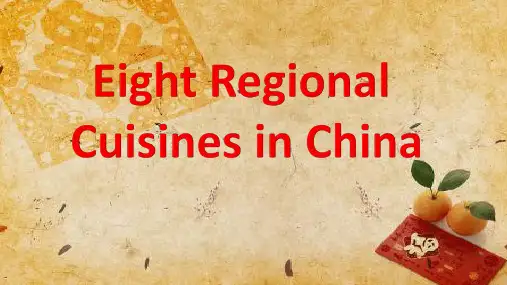
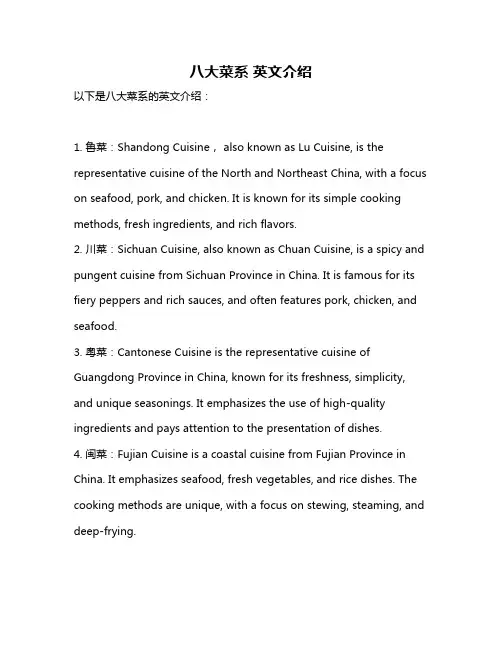
八大菜系英文介绍以下是八大菜系的英文介绍:1. 鲁菜:Shandong Cuisine, also known as Lu Cuisine, is the representative cuisine of the North and Northeast China, with a focus on seafood, pork, and chicken. It is known for its simple cooking methods, fresh ingredients, and rich flavors.2. 川菜:Sichuan Cuisine, also known as Chuan Cuisine, is a spicy and pungent cuisine from Sichuan Province in China. It is famous for its fiery peppers and rich sauces, and often features pork, chicken, and seafood.3. 粤菜:Cantonese Cuisine is the representative cuisine of Guangdong Province in China, known for its freshness, simplicity, and unique seasonings. It emphasizes the use of high-quality ingredients and pays attention to the presentation of dishes.4. 闽菜:Fujian Cuisine is a coastal cuisine from Fujian Province in China. It emphasizes seafood, fresh vegetables, and rice dishes. The cooking methods are unique, with a focus on stewing, steaming, and deep-frying.5. 苏菜:Jiangsu Cuisine is a representative cuisine of the Yangtze River Delta region in China. It emphasizes freshness, tenderness, and mild flavors. The cooking methods are diverse, including stewing, steaming, frying, and braising.6. 浙菜:Zhejiang Cuisine is a representative cuisine of the eastern region of China, known for its simplicity and unique flavors. It often features rice dishes, seafood, and various kinds of meat. The cooking methods include stewing, steaming, and frying.7. 湘菜:Xiang Cuisine is a spicy and pungent cuisine from Hunan Province in China. It emphasizes the use of fresh ingredients and fiery peppers, often featuring pork, chicken, and beef. The cooking methods include stewing, steaming, and deep-frying.8. 徽菜:Anhui Cuisine is a traditional Chinese cuisine from Anhui Province, known for its unique flavors and seasonings. The main ingredients include pork, chicken, duck, and various kinds of vegetables. The cooking methods include stewing, steaming, frying, and braising.。
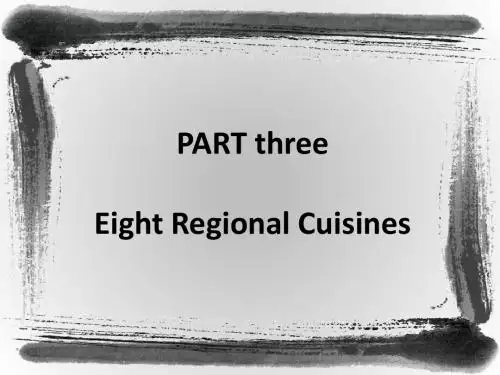
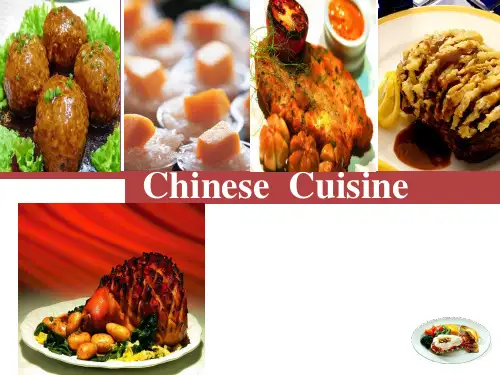
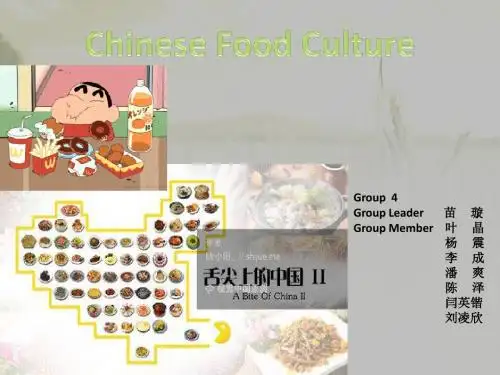
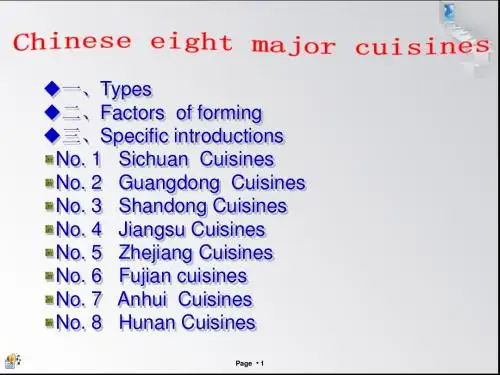
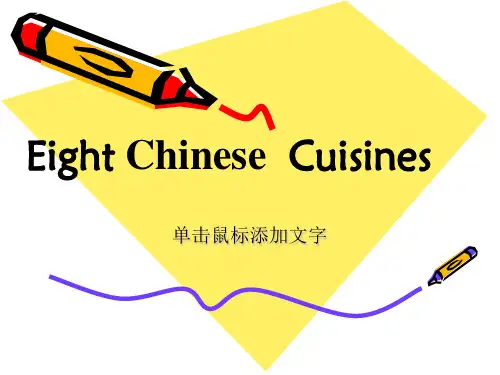
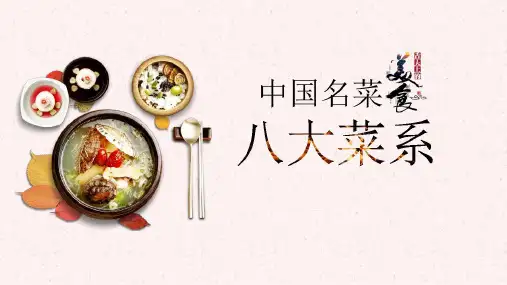
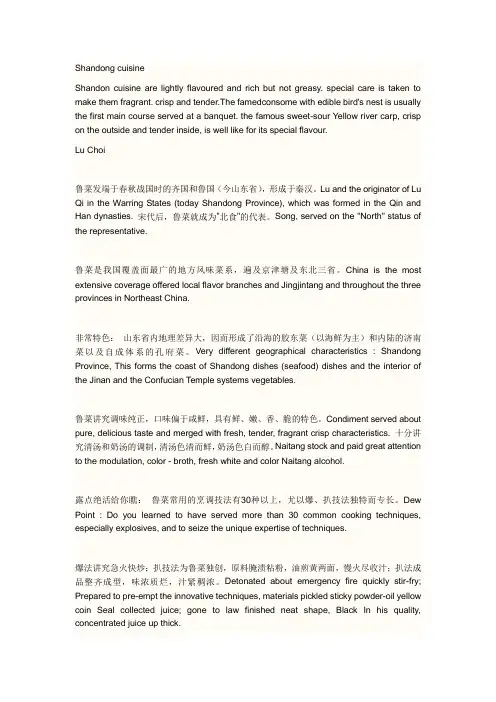
Shandong cuisineShandon cuisine are lightly flavoured and rich but not greasy. special care is taken to make them fragrant. crisp and tender.The famedconsome with edible bird's nest is usually the first main course served at a banquet. the famous sweet-sour Yellow river carp, crisp on the outside and tender inside, is well like for its special flavour.Lu Choi鲁菜发端于春秋战国时的齐国和鲁国(今山东省),形成于秦汉。
Lu and the originator of Lu Qi in the Warring States (today Shandong Province), which was formed in the Qin and Han dynasties. 宋代后,鲁菜就成为"北食"的代表。
Song, served on the "North" status of the representative.鲁菜是我国覆盖面最广的地方风味菜系,遍及京津塘及东北三省。
China is the most extensive coverage offered local flavor branches and Jingjintang and throughout the three provinces in Northeast China.非常特色:山东省内地理差异大,因而形成了沿海的胶东菜(以海鲜为主)和内陆的济南菜以及自成体系的孔府菜。
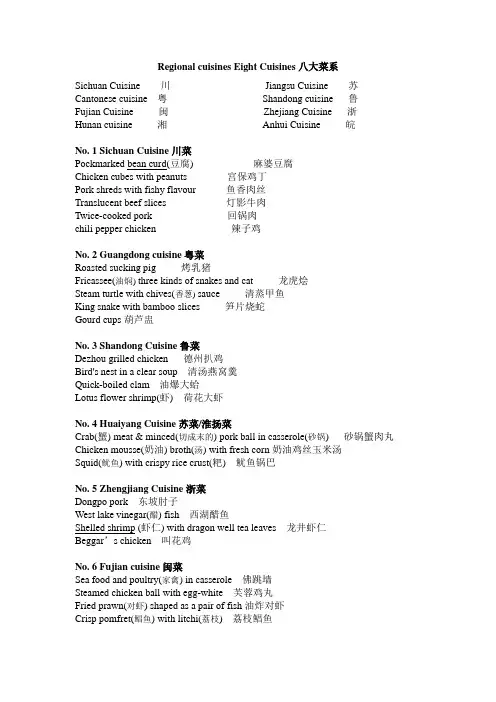
Regional cuisines Eight Cuisines八大菜系Sichuan Cuisine 川Jiangsu Cuisine 苏Cantonese cuisine 粤Shandong cuisine 鲁Fujian Cuisine 闽Zhejiang Cuisine 浙Hunan cuisine 湘Anhui Cuisine 皖No. 1 Sichuan Cuisine川菜Pockmarked bean curd(豆腐) 麻婆豆腐Chicken cubes with peanuts 宫保鸡丁Pork shreds with fishy flavour 鱼香肉丝Translucent beef slices 灯影牛肉Twice-cooked pork 回锅肉chili pepper chicken 辣子鸡No. 2 Guangdong cuisine粤菜Roasted sucking pig 烤乳猪Fricassee(油焖) three kinds of snakes and cat 龙虎烩Steam turtle with chives(香葱) sauce 清蒸甲鱼King snake with bamboo slices 笋片烧蛇Gourd cups葫芦盅No. 3 Shandong Cuisine鲁菜Dezhou grilled chicken 德州扒鸡Bird's nest in a clear soup 清汤燕窝羹Quick-boiled clam 油爆大蛤Lotus flower shrimp(虾) 荷花大虾No. 4 Huaiyang Cuisine苏菜/淮扬菜Crab(蟹) meat & minced(切成末的) pork ball in casserole(砂锅) 砂锅蟹肉丸Chicken mousse(奶油) broth(汤) with fresh corn奶油鸡丝玉米汤Squid(鱿鱼) with crispy rice crust(粑) 鱿鱼锅巴No. 5 Zhengjiang Cuisine浙菜Dongpo pork 东坡肘子West lake vinegar(醋) fish 西湖醋鱼Shelled shrimp (虾仁) with dragon well tea leaves 龙井虾仁Beggar’s chicken 叫花鸡No. 6 Fujian cuisine闽菜Sea food and poultry(家禽) in casserole 佛跳墙Steamed chicken ball with egg-white 芙蓉鸡丸Fried prawn(对虾) shaped as a pair of fish油炸对虾Crisp pomfret(鲳鱼) with litchi(荔枝) 荔枝鲳鱼No.7 Hunan Cuisine湘菜Dongan chicken 东安鸡Braised dried(红烧) pork with eel(鳗鱼) slices 红烧肉Steamed turtle 清蒸甲鱼Spring chicken with cayenne(红椒) pepper 麻辣仔鸡No. 8 Anhui Cuisine皖菜/徽菜Huangshan stewed pigeon 黄山醉鸽Gourd duck葫芦鸭Fricassee(油焖) pork sinew(腱) with egg white蛋花炖肉Crisp pork with pine nuts(松仁) 松仁排骨Other regional cuisine:其它菜系Hot pots /Chongqing hotpot 重庆火锅Muslim cuisine 清真菜Imperial-Simulating(仿皇室的) cuisine 仿膳菜Vegetarian cuisine素菜Northeastern cuisine东北菜Taiwan snack台湾小吃Famous delicacy:名菜北京烤鸭Beijing duck羊肉串Kebab狗不理包子Goubuli steamed stuffed bun; dumb dog dumpling过桥米线Crosses the bridge rice-flour noodle担担面dan dan mian (noodles in spicy garlic sauce)夫妻肺片Fuqi ox lung slice红烧蹄筋braised tendon with brown sauce麻婆豆腐Mapo bean curd西湖醋鱼West Lake sour and sweet fish水煮肉片stewed pork slices东坡肘子pork joint cooked in Su Dongpo's style鱼香肉丝shredded pork in fish flavored sauceStaple主食The staple food of Chinese is rice and flour. Southerners prefer rice and ground rice products, such as cooked rice, New Year rice cake, eight treasure rice pudding, and rice dumpling while northerners prefer cooked wheaten food. With wheat flour, they make steamed bread, stuffed bun, various kinds of noodles, and meat dumpling, etc.译文:中国人的主食以大米和面为主,南方人多吃大米和米粉制品,如米饭、年糕、八宝饭、汤圆。
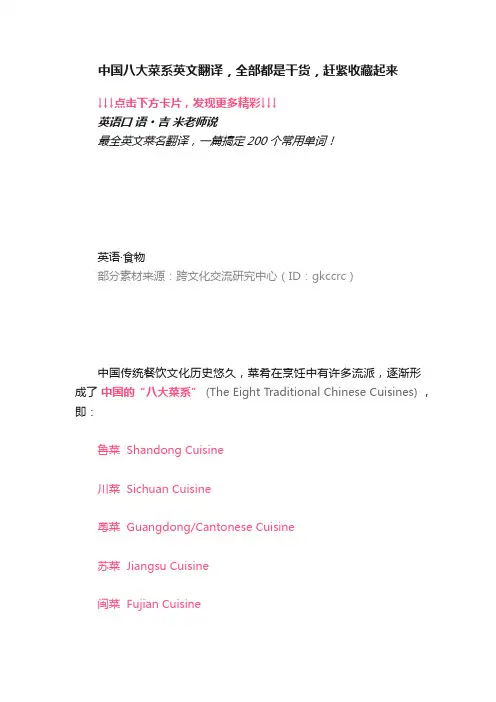
中国八大菜系英文翻译,全部都是干货,赶紧收藏起来↓↓↓点击下方卡片,发现更多精彩↓↓↓英语口语· 吉米老师说最全英文菜名翻译,一篇搞定200个常用单词!英语·食物部分素材来源:跨文化交流研究中心(ID:gkccrc)中国传统餐饮文化历史悠久,菜肴在烹饪中有许多流派,逐渐形成了中国的“八大菜系” (The Eight Traditional Chinese Cuisines) ,即:鲁菜 Shandong Cuisine川菜 Sichuan Cuisine粤菜 Guangdong/Cantonese Cuisine苏菜 Jiangsu Cuisine闽菜 Fujian Cuisine浙菜 Zhejiang Cuisine湘菜 Hunan Cuisine徽菜 Anhui Cuisine鲁菜Shandong Cuisine山东菜系,清淡,不油腻,以其香,鲜,酥,软而闻名。
Shandong cuisine/Confucian cuisine, clear, pure, and not greasy, is characterized by its emphasis on aroma, freshness, crispness and tenderness.常使用青葱(shallot) 和大蒜(garlic) 作为调料。
鲁菜注重汤品。
清汤清澈新鲜,而油汤外观厚重,味道浓重。
Soups are given much emphasis in Shandong cuisine. Its soup features clear and fresh while creamy soup looks thick and tastes strong.Notearoma 芳香 n.crisp 脆的 adj.葱烧海参Sea Cucumber Braised with Scallion一品豆腐Steamed Tofu Stuffed with Vegetables川菜Sichuan Cuisine四川菜系(Sichuan cuisine / Szechuan cuisine) ,是世界上最著名的中国菜系之一。
八大菜系中英文对照版中国的八大菜系与英文翻译中国自古就是一个拥有丰富饮食文化的国家,不同地区的菜系各具特色,味道各异。
中国的八大菜系被视为中国饮食文化的代表,它们是鲁菜、川菜、粤菜、苏菜、闽菜、浙菜、湘菜和徽菜。
下面将为大家介绍这些中国的八大菜系,并附上相应的英文翻译。
一、鲁菜(Shandong Cuisine)鲁菜,又称山东菜,是中国最著名的菜系之一,以山东地区为代表。
鲁菜讲究色、香、味的协调,注重原料的新鲜和烹调技巧的精湛。
主要特点是烹调方法多样,口味咸鲜,选料注重,制作讲究,炒、爆、炸、煮等技法熟练。
在中式烹饪中占有很重要的地位。
二、川菜(Sichuan Cuisine)川菜,又称川菜,是中国四大菜系之一,以四川地区为代表。
川味重油辣麻,以辣椒、花椒为主要调味料,口感鲜香麻辣,味道浓重,善于烹饪红烧、烧烤、干锅等菜肴。
三、粤菜(Cantonese Cuisine)粤菜,又称广东菜,以广东地区为代表。
粤菜讲究选料新鲜、制作精细,烹调技巧高超,口味清淡,口感鲜嫩,清淡鲜爽,色香味俱佳,被誉为中式烹饪之魁。
四、苏菜(Jiangsu Cuisine)苏菜,又称淮扬菜,以江苏地区为代表。
苏菜品种丰富,风味独特,以刀工精细,火工灵活,原汁原味见长,擅长烹调清蒸、红烧、炒、炸等烹调方法,口感鲜嫩。
五、闽菜(Fujian Cuisine)闽菜以福建地区为代表,是中国特色的一种菜系。
闽菜注重海鲜的烹调,食材新鲜,口味清淡,烹饪方法多样,尤其擅长海鲜的烹调,口感鲜嫩,清香爽口。
六、浙菜(Zhejiang Cuisine)浙菜,又称川菜,以浙江地区为代表。
浙菜清淡鲜香,以海鲜为主,注重鲜、嫩、淡、脆之味,注重保持菜品的本色,烹调技巧精湛,被誉为“中国菜中的山珍海味”。
七、湘菜(Hunan Cuisine)湘菜,又称湖南菜,以湖南地区为代表。
湘菜以酸辣咸鲜为主要口味,以辣椒、蒜、姜等为调味料,色香味俱佳,口感鲜甜。
Sichuan CuisineBean curd with mince and chilli oil 麻婆豆腐Braised pork knuckle with bean sauce豆瓣全肘Diced chicken with chilli pepper ; chicken cubes with peanuts宫保鸡丁Pork shreds with fishy flavour ;shredded pork,in Sichuan style鱼香肉丝Stewed scallop and turnip ball绣球干贝Steamed pork wrapped in lotus leaves 荷叶蒸肉Translucent beef slices灯影牛肉Spicy Sichuan-style tender chicken slices怪味鸡块Shrimp with green vegetables翡翠虾仁“chrysanthemum” in chafing dish 菊花火锅Shandong CuisineBird’s nest in clear soup清汤燕窝Braised sea whelks in brown sauce红烧海螺Dezhou grilled chicken德州扒鸡Braised sea slug with crab meat in brown sauce蟹烧海参Chinese yam in hot toffee拔丝山药Quick-boiled clam油爆大蛤Lotus flower,and shrimp荷花大虾Guangdong CuisineSweet-sour pork fillet with chilli 糖醋咕噜肉Sliced chicken with oyster sauce耗油滑鸡片Fricassee three kinds of snakes and cat三蛇龙虎会Shark’s fin with crab ovum虾黄鱼翅Roasted sucking pig烤乳猪Stewed crab meat and eggplant虾肉烧茄子Steamed turtle with chive sauce美味蒸甲鱼Stuffed duck shaped as gourd八珍葫芦鸭Crisp-skinned chicken脆皮鸡King snake with bamboo slices竹丝烩王蛇Gourd cups冬瓜盅Fujian CuisineSea food and poultry in casserole佛跳墙Steamed pork roll with rice flour and lotus leaf荷叶米粉肉Crisp pomfret with litchi荔枝鲳鱼Steamed chicken ball with egg-white蒸芙蓉鸡球Fried prawn shaped as a pair of fish太极明虾Sauté shredded whelks in rice wine sauce炝糟响螺Sauté sea cucumber with scallions葱烧刺参Fricassee shark’s fin with chicken白烧大翅Jiangsu CuisineYincai vegetables cooked with chicken slices银菜鸡丝Braised meat with vegetables & wine百菜酒焖肉Scallop wrapped in chicken breast slices鸡片包干贝Braised stuffed crucian carp荷包鲫鱼Stuffed pork breast with pine kernels松子肉Squid with crispy rice crust鱿鱼锅巴Crab meat & minced pork ball in casserole蟹粉狮子头Finless eel tail with grated garlic炝虎尾Chicken mousse broth with fresh corn 鸡茸玉米Fricassee ox tendon白汁牛人Zhejiang CuisineWest Lake water shield soup西湖莼菜汤Eight-jewel rice pudding wrapped with lotus leaves八宝荷叶饭 Beggar’s chicken 叫花鸡Dongpo pork东坡肉West Lake vinegar fish 西湖醋鱼Shelled shrimp with Dragon Well tea leaves 龙井虾仁Pork meat patties with crab meat蟹粉狮子头Hunan CuisineSteamed fried pork in black bean sauce 走油豆豉扣肉Dong’an chicken东安鸡Crispy rice crust with sea cucumber锅巴海参Spring chicken with cayenne pepper麻辣子鸡Steamed turtle清蒸甲鱼White bait in chafing dish银鱼火锅Braised sh ark’s fin in brown sauce红煨鱼翅Sweet lotus seed冰糖湘莲Anhui CuisineHuangshan stewed pigeon黄山炖鸽Fricassee pork sinew (tendon )with egg white芙蓉蹄筋Crispy pork with pine nuts松子米酥肉Fuliji stewed chicken符离集烧鸡Spicy fried chicken椒盐米鸡Gourd duck葫芦鸭子。
八大菜系英文介绍简介版1. Sichuan CuisineSichuan cuisine, originating from the southwestern province of China, is known for its bold and spicy flavors. The use of Sichuan peppercorns gives the dishes a unique numbing sensation that sets it apart from other Chinese styles. From fiery hot pot to mouth-numbing mapo tofu, Sichuan cuisine is not for the faint of heart.2. Cantonese CuisineCantonese cuisine, also known as Guangdong cuisine, is hailed as one of the most diverse and sophisticated styles in Chinese cooking. Characterized by its emphasis on fresh ingredients and delicate preparation techniques, Cantonese dishes are often steamed, stir-fried, or braised. From dim sum to roast duck, Cantonese cuisine is a feast for the senses.3. Shandong CuisineShandong cuisine, originating from the eastern coastal province of China, is known for its rich flavors and generous use of seafood. The dishes are often hearty and filling, with a focus on soups and stews.From savory seafood soup to braised abalone, Shandong cuisine offersa taste of the sea.4. Jiangsu CuisineJiangsu cuisine, also known as Huaiyang cuisine, is characterized by its light and delicate flavors, with an emphasis on freshness and subtlety. The dishes are often steamed or braised, with a focus on preserving the natural flavors of the ingredients. From sweet and sour carp to braised pork belly, Jiangsu cuisine is a testament to the art of simple cooking.5. Zhejiang CuisineZhejiang cuisine, originating from the eastern coastal province of China, is known for its fresh and light flavors, with an emphasis on seafood and vegetables. The dishes are often lightly seasoned and served raw or barely cooked, allowing the natural flavors of the ingredients to shine. From Dongpo pork to West Lake fish in vinegar sauce, Zhejiang cuisine is a celebration of the region's natural bounty.6. Fujian CuisineFujian cuisine, originating from the southeastern province of China, is known for its seafood-based dishes and complex use of spices and seasonings. The cuisine draws inspiration from neighboring Taiwan and Southeast Asia, resulting in a unique blend of flavors and cookingtechniques. From fish ball soup to cured meats, Fujian cuisine offers a taste of the region's rich history and cultural influences.7. Hunan CuisineHunan cuisine, originating from the southern province of China, is known for its bold and spicy flavors, with a focus on chili peppers and Sichuan peppercorns. The dishes are often stir-fried or stewed, with a strong emphasis on heat and flavor. From spicy chicken to fish head soup, Hunan cuisine is not for the faint of heart.8. Anhui CuisineAnhui cuisine, originating from the eastern province of China, is known for its simplicity and elegance, with a focus on natural flavors and fresh ingredients. The dishes are often lightly seasoned and served in a minimalist style, allowing the natural flavors of the ingredients to take center stage. From stewed bamboo shoots to braised turtle, Anhui cuisine offers a taste of the region's rustic charm and natural beauty.。
鲁、川、粤、闽、苏、浙、湘、徽等菜系,即被人们常说的中国“八大菜系”中国八大菜系之英文版Eight Cuisines(八大菜系)China covers a large territory and has many nationalities, hence a variety of Chi nese food with different but fantastic and mouthwatering flavor. Since China's lo cal dishes have their own typical characteristics, generally, Chinese food can be roughly divided into eight regional cuisines, which has been widely accepted aro und. Certainly, there are many other local cuisines that are famous, such as Beij ing Cuisine and Shanghai Cuisine.Shandong CuisineConsisting of Jinan cuisine and Jiaodong cuisine, Shandong cuisine, clear, pure a nd not greasy, is characterized by its emphasis on aroma, freshness, crispness an d tenderness. Shallot and garlic are usually used as seasonings so Shangdong dis hes tastes pungent usually. Soups are given much emphasis in Shangdong dishes. Thin soup features clear and fresh while creamy soup looks thick and tastes str ong. Jinan cuisine is adept at deep-frying, grilling, frying and stir-frying while Ji aodong division is famous for cooking seafood with fresh and light taste. Shandong is the birthplace of many famous ancient scholars such as Confucious and Mencius. And much of Shandong cuisine's history is as old as Confucious h imself, making it the oldest existing major cuisine in China. But don't expect to gain more wisdom from a fortune at a Shandong restaurant in the West since f ortune s aren't even indigenous to China.Shandong is a large peninsula surrounded by the sea to the East and the Yellow River meandering through the center. As a result, seafood is a major componen t of Shandong cuisine. Shandong's most famous dish is the Sweat and Sour Car p. A truly authentic Sweet and Sour Carp must come from the Yellow River. B ut with the current amount of pollution in the Yellow River, you would be bett er off if the carp was from elsewhere. Shandong dishes are mainly quick-fried, r oasted, stir-fried or deep-fried. The dishes are mainly clear, fresh and fatty, perfe ct with Shandong's own famous beer, Qingdao BeerSichuan Cuisine pungentSichuan Cuisine, known often in the West as Szechuan Cuisine, is one of the m ost famous Chinese cuisines in the world. Characterized by its spicy and pungen t flavor, Sichuan cuisine, prolific of tastes, emphasizes on the use of chili. Pepp er and prickly ash(花椒) also never fail to accompany, producing typical exciting tastes. Besides, garlic, ginger and fermented soybean (豆酱)are also used in t he cooking process. Wild vegetables and animals are usually chosen as ingredients, while frying, frying without oil, pickling and braising are applied as basic co oking techniques. It cannot be said that one who does not experience Sichuan fo od ever reaches China.If you eat Sichuan cuisine and find it too bland,then you are probably not eati ng authentic Sichuan cuisine. Chili peppers and prickly ash are used in many di shes, giving it a distinctively spicy taste, called ma in Chinese. It often leaves a slight numb sensation in the mouth. However, most peppers were brought to C hina from the Americas in the 18th century so you can thank global trade for much of Sichuan cuisine's excellence. Sichuan hot pots are perhaps the most fa mous hotpots in the world, most notably the Yuan Yang (mandarin duck) Hotpo t half spicy and half clear.Guangdong CuisineCantonese food originates from Guangdong, the southernmost province in China. The majority of overseas Chinese people are from Guangdong (Canton) so Canto nese is perhaps the most widely available Chinese regional cuisine outside of Ch ina.Cantonese are known to have an adventurous palate, able to eat many different kinds of meats and vegetables. In fact, people in Northern China often say that Cantonese people will eat anything that flies except airplanes, anything that mov es on the ground except trains, and anything that moves in the water except boa ts. This statement is far from the truth, but Cantonese food is easily one of the most diverse and richest cuisines in China. Many vegetables originate from othe r parts of the world. It doesn't use much spice, bringing out the natural flavor o f the vegetables and meats.Tasting clear, light, crisp and fresh, Guangdong cuisine, familiar to Westerners, u sually chooses raptors and beasts to produce originative dishes. Its basic cooking techniques include roasting, stir-frying, sauteing, deep-frying, braising, stewing a nd steaming. Among them steaming and stir-frying are more commonly applied t o preserve the natural flavor. Guangdong chefs also pay much attention to the ar tistic presentation of dishes.Fujian CuisineConsisting of Fuzhou Cuisine, Quanzhou Cuisine and Xiamen Cuisine, Fujian Cu isine is distinguished for its choice seafood, beautiful color and magic taste of s weet, sour, salty and savory. The most distinct features are their "pickled taste". Jiangsu CuisineJiangsu Cuisine, also called Huaiyang Cuisine, is popular in the lower reach of t he Yangtze River. Aquatics as the main ingredients, it stresses the freshness of materials. Its carving techniques are delicate, of which the melon carving techniq ue is especially well known. Cooking techniques consist of stewing, braising, roa sting, simmering, etc. The flavor of Huaiyang Cuisine is light, fresh and sweet a nd with delicate elegance. Jiangsu cuisine is well known for its careful selectionof ingredients, its meticulous preparation methodology, and its not-too-spicy, not -too-bland taste. Since the seasons vary in climate considerably in Jiangsu, the c uisine also varies throughout the year. If the flavor is strong, it isn't too heavy; if light, not too bland.Zhejiang CuisineComprising local cuisines of Hangzhou, Ningbo and Shaoxing, Zhejiang Cuisine, not greasy, wins its reputation for freshness, tenderness, softness, smoothness of its dishes with mellow fragrance. Hangzhou Cuisine is the most famous one a mong the three.Hunan cuisineHunan cuisine consists of local Cuisines of Xiangjiang Region, Dongting Lake a nd Xiangxi coteau. It characterizes itself by thick and pungent flavor. Chili, pep per and shallot are usually necessaries in this division.Anhui CuisineAnhui Cuisine chefs focus much more attention on the temperature in cooking a nd are good at braising and stewing. Often hams will be added to improve taste and sugar candy added。